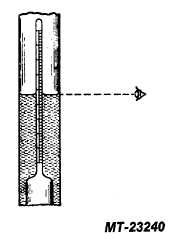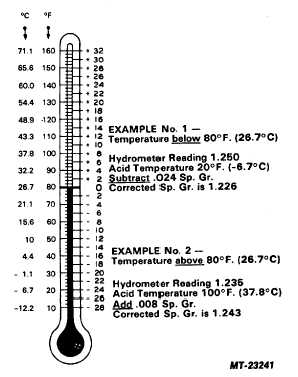|
| |
TRUCK SERVICE MANUAL
TM 5-4210-230-14&P-1
Fig. 6 Correct Method of Reading Hydrometer
(Eye on Level with Liquid Surface)
Because
there
are
many
different
types
of
battery
hydrometers
available,
always
follow
manufacturer's
instructions.
TEMPERATURE CORRECTION
Hydrometer floats are calibrated to give a true reading at one
fixed temperature only. A correction factor must be applied
for any specific gravity reading made when the electrolyte
temperature is not 26.7° C (80° F).
A temperature correction must be used because the
electrolyte will expand and become less dense when heated.
The float will sink lower in the less dense solutions and give a
lower specific gravity reading. The opposite occurs if the
electrolyte is cooled. It will shrink in volume, becoming more
dense. The float will rise higher and read too high.
A correction factor of .004 specific gravity sometimes referred
to as 4 "points" of "gravity") is used for each 5.5° C (10° F)
change in temperature. Four "points of gravity" (.004) are
added to the indicated reading for each 5.5° C (10° F)
increment above 26.7° C (80° F) and four points are
subtracted for each 5.5° C (10° F) increment below 26.7° C
(80°
F). This correction is important at extremes of
temperature because it can become a substantial value.
Figure 7 illustrates the correction for hydrometer readings
when the acid temperature is above or below 26.7° C (80° F).
In example No. 1, in cold weather, a partially discharged
battery in a vehicle at 6.7° C (+20° F) might read 1.250
indicating it was almost fully charged. However, when the
correction factor is applied, the true value is only 1.226.
Example No. 2 could be encountered in a battery exposed to
the sun in hot weather. Also, electrolyte frequently reaches
43° C (110° F) in service in warm weather. The 1.235 specific
gravity reading might indicate too low a state of charge to
install in a vehicle or that there is a problem in the electrical
system if the battery is in service. However, the true reading
of 1.247 may not be unreasonably low depending on the
length of storage of the battery or the type of service which it
has been experiencing in the vehicle.
Fig. 7 Specific Gravity Temperature Correction Values
SPECIFIC
GRAVITY
DETERMINES
ELECTROLYTE
FREEZING POINT
Specific gravity of the electrolyte determines the temperature
at which a battery will be harmed or damaged by freezing. A
fully
charged
battery
can
be
stored
at
sub-freezing
temperatures without freezing the electrolyte. However, as a
battery approaches the discharged condition, the electrolyte
will freeze at higher temperatures. Table 2 shows the
approximate freezing points of electrolyte at various specific
gravities.
CTS-2771 Page 7
PRINTED IN UNITED STATES OF AMERICA
|


